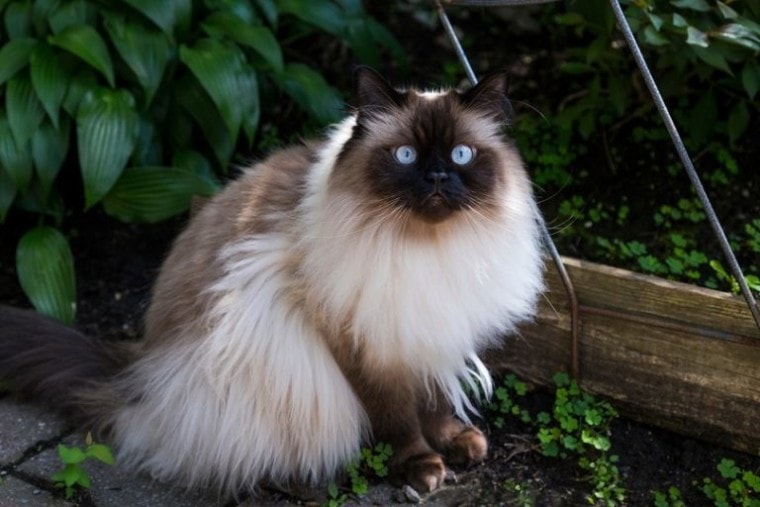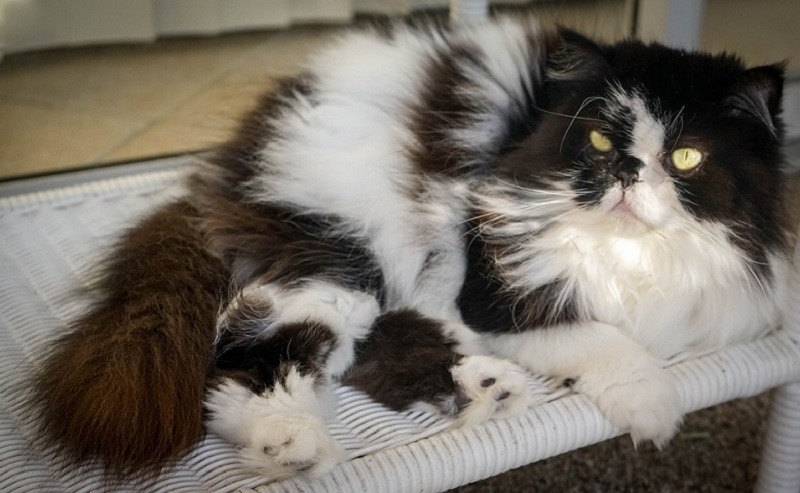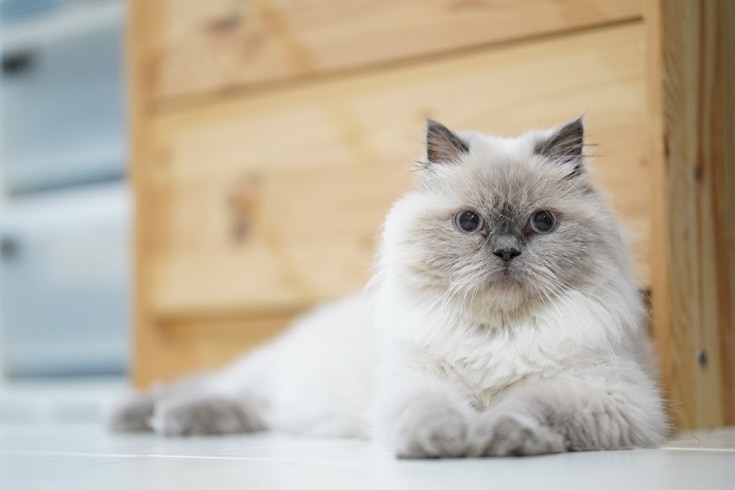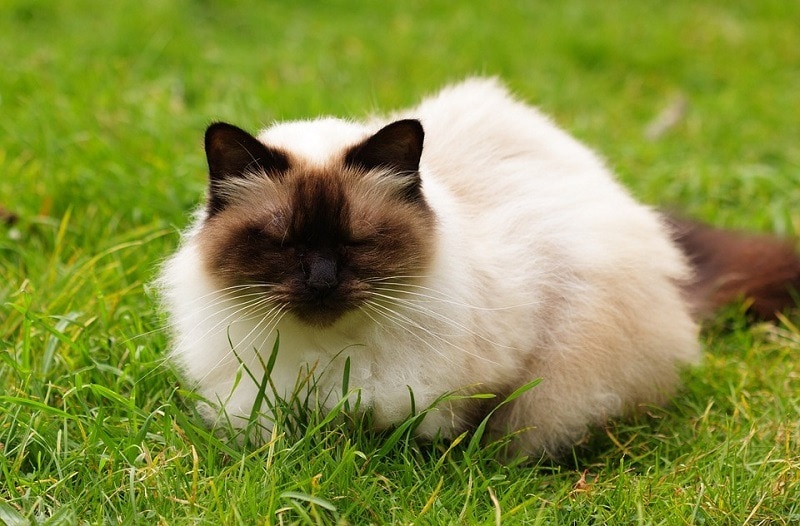
Click Below to Skip Ahead
At first glance, you’d be forgiven for mistaking the Himalayan for a Persian, as both breeds have long, fluffy coats, large eyes, and flat faces. They have similar personalities too, with a sweet and gentle temperament that is great for households that want a laid-back gentle feline. It comes as no surprise that the Himalayan is one of the most popular cat breeds in the United States, and their popularity continues to grow.
Breed Overview
Height:
10 – 12 inches
Weight:
7 – 12 pounds
Lifespan:
9 – 15 years
Colors:
Cream with points in chocolate, seal, blue, lilac, red, and blue-cream and various tortie and lynx points.
Suitable for:
Households looking for a quiet, mellow, docile cat
Temperament:
Sweet, affectionate, quiet, gentle, independent
The Himalayan is a medium-sized breed, although they appear far larger due to their long coat of fluffy fur. They are stocky cats, though, with a well-muscled body and fairly short tails. The most endearing trait of these cats, however, is their large, beautiful eyes, broad head, and flat face. Their playful and affectionate yet not overly needy character is likely the breed’s biggest draw, along with their unique looks. This is a wonderful cat to own.
If the Himalayan, or “Himmie,” as they are affectionately known, sounds like the cat for you, read on for more info about these gorgeous felines.
Himalayan Characteristics
Himalayan Kittens
Before bringing home a Himalayan cat, you need to know that they require a ton of grooming. Their long, luxurious coats need daily brushing to prevent knotting and matting and can be fairly high maintenance. That said, these cats are low maintenance in every other regard and aren’t hugely attention-seeking animals. Himalayan kittens are adorable, although it’s important to note that they are born without their signature pointed colors: They are usually born white or cream and only develop their darker points at around 6-8 weeks.
It’s also important to mention that Himalayans commonly suffer from several health issues due to their Persian genetics, sometimes leading to breathing problems, eye issues, and dental problems.
Temperament & Intelligence of the Himalayan
The Himalayan is the ideal indoor companion: laid-back, mellow, and sweet-natured.

They are more active than their Persian parents but less so than the Siamese, making an ideal feline for those who want a placid cat that is still up for a play session from time to time. While the Himalayan is not overly attention-seeking, they still love to cuddle and will happily sit on your lap — when they’re in the mood!
They are friendly cats with the people they know and love but can be wary of strangers, although they tend to warm to new faces quickly. They don’t enjoy too much loud activity and prefer peace and quiet where they can stick to their routine of laying in warm places! They are calm animals that can be almost ornamental in their presence, happily resting on top of the sofa and welcoming the occasional petting.
Are These Cats Good for Families? 👪
Himalayans can make great family pets, although they prefer a quiet home without too much loud activity. Families with very young children may consider a more playful breed, as the Himalayan prefers their own space and tends to socialize on their own terms. Of course, slightly older children can be taught to handle Himalayans correctly, in which case, they are truly wonderful family pets.
Does This Breed Get Along With Other Pets?
Himalayans, like most cats, are not particularly fond of dogs but can make friends if the dog is not overly energetic. A highly boisterous dog is definitely not suited for a Himalayan and may cause them anxiety. Himalayans are generally great with other cats and don’t have a strong prey drive like many other breeds, making them ideal to have around if you own any smaller pets, like hamsters or rabbits.
Things to Know When Owning a Himalayan
Bringing home any cat is a massive responsibility that should never be taken lightly, and cats like the Himalayan require higher-than-average care and grooming.
The extra effort is certainly worth it, though, and here are a few additional tips to keep your cat healthy and happy.
Food & Diet Requirements 
As with any cat breed, high-quality protein is essential in a Himalayan’s diet. All cats are obligate carnivores, and the first listed ingredient on the food that you purchase for your Himalayan should have an animal-based protein source. Himalayans don’t require any special ingredients in their diet, although they can benefit from eating plenty of omega-3 and omega-6 fatty acids, as this will keep their coat shiny and healthy.
Another important consideration is that Himalayans can have a difficult time eating due to their flat faces and breathing difficulty. There are commercial cat kibble brands that make kibble in shapes that are easier for flat-faced cats to eat, as well as specially designed bowls.

Exercise 🐈
Himalayans are laid-back, placid cats that spend most of their time napping and relaxing. They can be playful when the mood hits but are definitely not overly energetic or active. Still, they need regular exercise just like any cat breed; otherwise, they can become overweight, which can lead to a domino effect of other health issues.
Himalayans can be difficult to entice into exercise, as they generally are not fans of climbing, making cat trees unsuitable for the breed. Still, exercise is vital, and there are various other means to try out. It’s a good idea to get them to play with an interactive toy or ball for at least 20-30 minutes a day and having another cat for them to play with can help too.
Training 🧶
Himalayans are intelligent cats and can be trained easily to use litter boxes, respond to basic commands, and even walk on leashes. That said, they are happy to be indoors and don’t enjoy long walks that much. These cats will benefit from very short training sessions; otherwise, they can quickly lose interest. It’s a great idea to use treats as motivation for training and rewarding your cat when they successfully obey a command.

Grooming ✂️
Grooming and brushing are at the top of the list of priorities when owning a Himalayan. The long, luxurious coat of this cat needs daily brushing to keep it from matting and knotting, and it can attract a great deal of dirt too. Cat litter is another problem with these cats because it can easily get stuck to their long fur. You’ll need to keep an eye out for any attached litter and make sure their litter box stays clean at all times. While most cats rarely need to be bathed, the Himalayan will benefit greatly from an occasional bath, even though they’ll likely protest it!
Health and Conditions 🏥
Himalayans are prone to several different hereditary health conditions, mostly associated with their flat face, which causes difficulty breathing and dental issues. Other, more serious conditions include the following.
 Male vs. Female
Male vs. Female
The final choice to make before bringing home your Himalayan is whether to get a male or female. The temperaments of male and female Himalayans are fairly similar, and both make for wonderful, loving pets. Your choice will largely depend on what, if any, cats you already have at home, as a same-sex pairing may cause fighting, even with the mild-mannered Himalayan.
3 Little-Known Facts About the Himalayan
1. Himalayans are not a natural breed
Himalayans were created by crossing a Persian with a Siamese, with the aim of developing the beautiful pointed coat and blue eyes of the Siamese with the fluffy coat of the Persian.
Both the Himalayan’s parent breeds are what’s called “natural” breeds, meaning they weren’t created by human intervention and development. Both the Cat Fanciers Association and the American Cat Association consider the Himalayan a different color variety of the Persian and don’t recognize it as a separate breed.
2. Himalayans are named after their genes
The gene responsible for the pointed coloration in Siamese cats is known as the “Himalayan” gene and is found in several other cat breeds too. After the development of the crossing between the Siamese and Persian, the Himalayan got their name due to this unique gene and pointed coat.
Interestingly, the color points on the Himalayan’s coat are responsive to temperature. If your cat grows up in a warmer climate, their coat will remain white or cream, possibly with slight pointing, but if they live in a colder climate, their points will darken.
3. Himalayans have several inherited health issues
One of the traits that make the Himalayan so uniquely adorable is also responsible for causing health issues, and there is controversy around whether the breed, along with Persians, should be allowed to be developed further. The Himalayan’s flat face can cause serious breathing difficulties, especially in warm climates or if they exert themselves.

Conclusion
The Himalayan is a laid-back, sweet, and docile feline that is loved the world over for their gentle personality. While these cats love being around their owners, they are not overly attention-demanding, which is great for owners who are not always at home. They generally get along great with dogs and other cats and don’t have a strong prey drive. This is ideal if you have other small pets at home, but not ideal if you have rat problems!
It’s important to note that these cats require a great deal of regular grooming and are known to suffer from several inherited health problems. This requires dedication, but in every other way, these cats are low maintenance. If you’re looking for a loving, docile cat to have around the home, the Himalayan is a great choice.
Other fun cat breeds:
- Exotic Shorthair Cat Breed Info: Pictures, Temperament & Traits
- Devon Rex Cat Breed Info: Pictures, Temperament & Traits
Featured Image Credit: Anne Richard, Shutterstock







